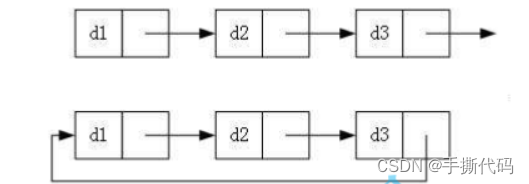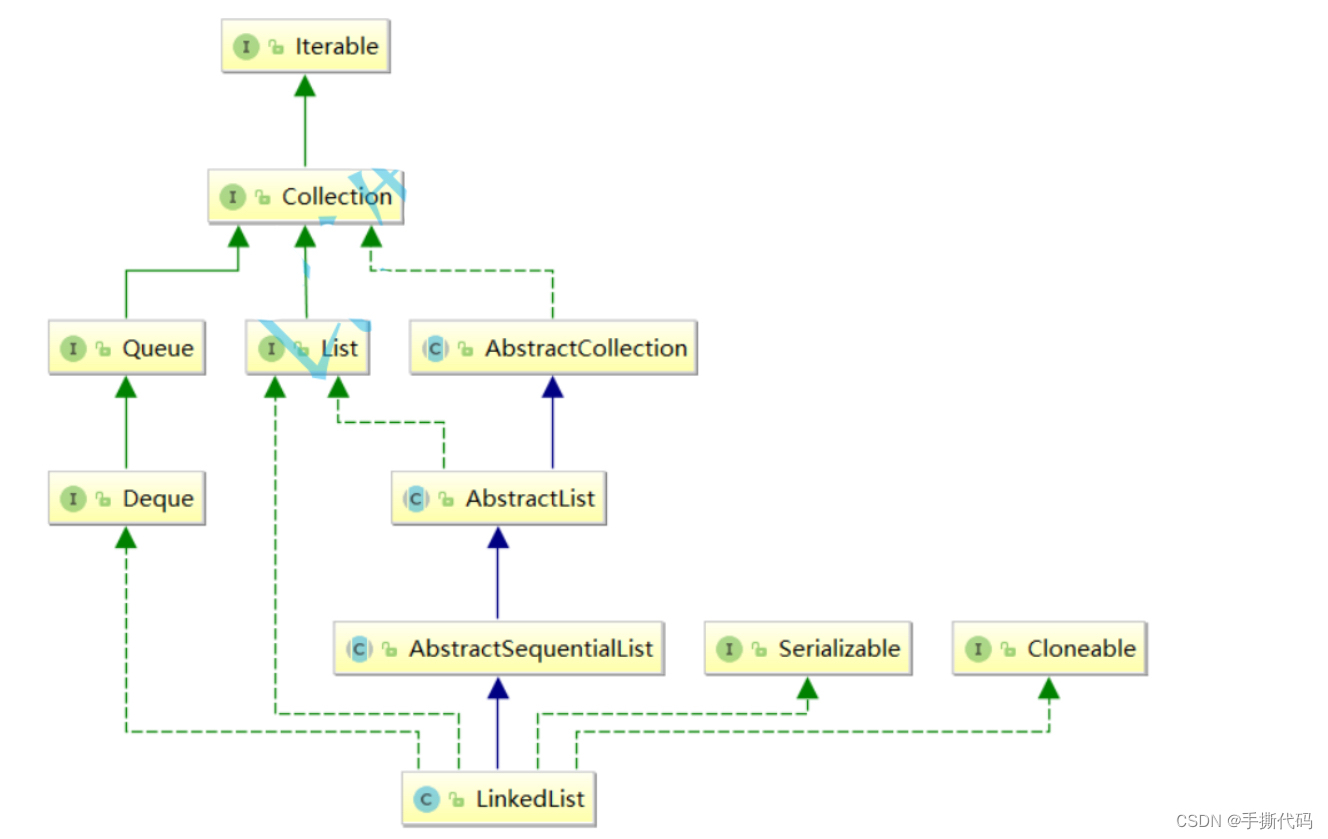LinkedList与链表
[本节目标]
1.ArrayList的缺陷
2.链表
3.链表相关oj题
4.LinkedList的模拟实现
5.LinkedList的使用
6.ArratList和LinkedList的区别
1. ArrayList的缺陷
上篇博客已经熟悉了ArrayList的使用,并且进行了简单模拟实现,ArrayList底层使用数组来储存元素:
public class ArrayList<E> extends AbstractList<E>
????implements List<E>, RandomAccess, Cloneable, java.io.Serializable
{
?// ...
?// 默认容量是10
??private static final int DEFAULT_CAPACITY = 10;
??//...
?
??// 数组:用来存储元素
??transient Object[] elementData; // non-private to simplify nested class access
?
??// 有效元素个数
??private int size;
??public ArrayList(int initialCapacity) {
????if (initialCapacity > 0) {
??????this.elementData = new Object[initialCapacity];
???} else if (initialCapacity == 0) {
??????this.elementData = EMPTY_ELEMENTDATA;
???} else {
??????throw new IllegalArgumentException("Illegal Capacity: "+
???????????????????????initialCapacity);
???}
?}
?
??由于其底层是一段连续空间,当在ArrayList任意位置插入或者删除元素时,就需要将后续元素往前或者往后搬移,时间复杂度O(n),效率比较低,因此ArrayList不适合任意位置插入和删除比较多的场景,因此java又引入了LinkedList,即链表结构.
2.? 链表
2.1 链表的概念及结构
链表是一种逻辑连续,物理结构非连续的存储结构.数据元素的逻辑顺序是通过链表中的引用链接次序实现的.

1. 从图上可以看出来,链式结构在逻辑上是连续的,但是在物理结构上是不一定连续的.
2.现实中的结点一般都是从堆上申请出来的
3.从堆上申请的空间,是按照一定策略来分配的,两次申请的空间可能连续,也可能不连续
?实际中链表的结构非常多样,以下情况结合起来就有8种链表结构:
1.单向或者双向

2.带头或者不带头

3.循环或者非循环

虽然有很多的链表的结构,但是我们重点掌握两种:
1.无头单向非循环链表,结构简单,一般不会单独来存数据,实际中更多是作为其他数据结构的子结构.如哈希桶,图的邻接表,另外这种结构在笔试面试中出现很多.

2.无头双向链表:在java中的集合框架中LinkedList底层实现就是无头双向链表
2.2 链表的使用和体现
// 1、无头单向非循环链表实现
public class SingleLinkedList {
??//头插法
??public void addFirst(int data){
?}
??//尾插法
??public void addLast(int data){
?}
??//任意位置插入,第一个数据节点为0号下标
??public void addIndex(int index,int data){
?}
??//查找是否包含关键字key是否在单链表当中
??public boolean contains(int key){
????return false;
?}
??//删除第一次出现关键字为key的节点
??public void remove(int key){
?}
??//删除所有值为key的节点
??public void removeAllKey(int key){
?}
??//得到单链表的长度
??public int size(){
????return -1;
?}
??public void clear() {
?}
?
??public void display() {}
}
3. LinkedList的模拟实现
public class MyListNode {
static class ListNode {
int value;
public ListNode next;
public ListNode prev;
public ListNode(int value) {
this.value = value;
}
}
public ListNode head;
public void createlist() {
ListNode node1 = new ListNode(1);
ListNode node2 = new ListNode(2);
ListNode node3 = new ListNode(3);
ListNode node4 = new ListNode(4);
node1.next = node2;
node2.next = node3;
node3.next = node4;
this.head = node1;
}
public void addFirst(int data){
Listnode node = new Listnode(data);
if(head==null){
head=node;
last = node;
}
else{
node.next=head;
node.next = head;
head.prev = node;
head= node;
}
}
public void addLast(int data){
Listnode node = new Listnode(data);
if(head==null){
head=node;
last=node;
}
else{
last.next = node;
node.prev=last;
last =node;
}
}
public void clear() {
ListNode cur = head;
while(cur != null){
ListNode curr = cur.next;
cur.next =null;
cur = curr;
}
head = null;
}
public void remove(int key){
Listnode cur =head;
while(cur != null){
if(cur.val == key){
head = head.next;
if(head==null){
last=null;
}
else{
head.prev.next= cur.next;
if(cur.next==null){
last=last.next;
}
}
return;
}
else{
cur =cur.next;
}
}
}
public void removeAllKey(int key) {
Listnode cur = head;
while (cur != null) {
if (cur.val == key) {
head = head.next;
if (head == null) {
last = null;
} else {
head.prev.next = cur.next;
if (cur.next == null) {
last = last.next;
}
}
}
cur = cur.next;
}
}
public void addIndex(int index,int data){
Listnode node = new Listnode(data);
int len = size();
if(index<0 || index>size()){
return;
}
if(index==0){
addFirst(data);
}
if(index==size()){
addLast(data);
}
Listnode cur = head;
int count =0;
while(count<index){
cur=cur.next;
count++;
}
cur.prev.next = node;
node.prev=cur.prev;
node.next=cur;
cur.prev = node;
}
public boolean contains(int key) {
ListNode cur = head;
while (cur != null){
if(cur.value == key){
return true;
}
cur = cur.next;
}
return false;
}
public int size() {
int count = 0;
ListNode cur = head;
while(cur != null){
count++;
cur = cur.next;
}
return count;
}
public void display () {
ListNode cur = head;
while (cur.next != null) {
System.out.println(cur.value + " ");
cur = cur.next;
}
System.out.println(cur.value);
}
}
4. LinkedList的使用
4.1 什么是LinkedList
LinkedList的底层是双向链表结构(链表后面介绍),由于链表没有将元素存储在连续的空间中,元素存储在单独的节点中,然后通过引用将节点连接起来了,因此在在任意位置插入或者删除元素时,不需要搬移元素,效率比较高。

[说明]
1.LinkedList实现了List接口
2.LinkedList的底层使用了双向链表
3.LinkedList没有实现RandomAccess接口,因此LinkedList不支持随机访问
4.LinkedList的任意位置插入和删除元素时效率比较高,时间复杂度为O(1)
5.LinkedList比较适合任意位置插入的场景?
4.2 LinkedList的使用
1.LinkedList的构造

public static void main(String[] args) {
List<Integer> list1 = new LinkedList<>();
List<String> list2 = new ArrayList<>();
list2.add("javase");
list2.add("javaee");
list2.add("数据结构");
List<String> list3 = new LinkedList<>(list2);
}2.LinkedList的其他常用方法介绍
方法? ? ? ? ? ? ? ? ? ? ? ? ? ? ? ? ? ? ? ? ? ? ? ? ? ? ? ? ? ? ? ?解释
boolean add(E e)? ? ? ? ? ? ? ? ? ? ? ? ? ? ? ? ? ? ? ? ? ?尾插 e
void add(int index, E element)? ? ? ? ? ? ? ? ? ? ? ?将 e 插入到 index 位置
boolean addAll(Collection<? extends E> c)? ?尾插 c 中的元素
E remove(int index)? ? ? ? ? ? ? ? ? ? ? ? ? ? ? ? ? ? ? ??删除 index 位置元素
boolean remove(Object o)? ? ? ? ? ? ? ? ? ? ? ? ? ? ? 删除遇到的第一个 o
E get(int index)? ? ? ? ? ? ? ? ? ? ? ? ? ? ? ? ? ? ? ? ? ? ? ?获取下标 index 位置元素
E set(int index, E element)? ? ? ? ? ? ? ? ? ? ? ? ? ? ?将下标 index 位置元素设置为 element
void clear()? ? ? ? ? ? ? ? ? ? ? ? ? ? ? ? ? ? ? ? ? ? ? ? ? ? ?清空
boolean contains(Object o)? ? ? ? ? ? ? ? ? ? ? ? ? ? 判断 o 是否在线性表中
int indexOf(Object o)? ? ? ? ? ? ? ? ? ? ? ? ? ? ? ? ? ? ? ?返回第一个 o 所在下标
int lastIndexOf(Object o)? ? ? ? ? ? ? ? ? ? ? ? ? ? ? ? ? 返回最后一个 o 的下标
List<E> subList(int fromIndex, int toIndex)? ? ? 截取部分 list
public static void main(String[] args) {
??LinkedList<Integer> list = new LinkedList<>();
??list.add(1); ?// add(elem): 表示尾插
??list.add(2);
??list.add(3);
??list.add(4);
??list.add(5);
??list.add(6);
??list.add(7);
??System.out.println(list.size());
??System.out.println(list);
?
??// 在起始位置插入0
??list.add(0, 0); ?// add(index, elem): 在index位置插入元素elem
??System.out.println(list);
?
??list.remove(); ????// remove(): 删除第一个元素,内部调用的是removeFirst()
??list.removeFirst(); ??// removeFirst(): 删除第一个元素
??list.removeLast(); ??// removeLast(): 删除最后元素
??list.remove(1); ?// remove(index): 删除index位置的元素
??System.out.println(list);
?
??// contains(elem): 检测elem元素是否存在,如果存在返回true,否则返回false
??if(!list.contains(1)){
????list.add(0, 1);
?}
??list.add(1);
??System.out.println(list);
??System.out.println(list.indexOf(1)); ?// indexOf(elem): 从前往后找到第一个elem的位置
??System.out.println(list.lastIndexOf(1)); ?// lastIndexOf(elem): 从后往前找第一个1的位置
??int elem = list.get(0); ??// get(index): 获取指定位置元素
??list.set(0, 100); ?????// set(index, elem): 将index位置的元素设置为elem
??System.out.println(list);
?
??// subList(from, to): 用list中[from, to)之间的元素构造一个新的LinkedList返回
??List<Integer> copy = list.subList(0, 3);
??System.out.println(list);
??System.out.println(copy);
??list.clear(); ???????// 将list中元素清空
??System.out.println(list.size());
}3.LinkedList的遍历
public static void main(String[] args) {
??LinkedList<Integer> list = new LinkedList<>();
??list.add(1); ?// add(elem): 表示尾插
??list.add(2);
??list.add(3);
??list.add(4);
??list.add(5);
??list.add(6);
??list.add(7);
??System.out.println(list.size());
??// foreach遍历
??for (int e:list) {
????System.out.print(e + " ");
?}
??System.out.println();
??// 使用迭代器遍历---正向遍历
??ListIterator<Integer> it = list.listIterator();
??while(it.hasNext()){
????System.out.print(it.next()+ " ");
?}
??System.out.println();
??// 使用反向迭代器---反向遍历
??ListIterator<Integer> rit = list.listIterator(list.size());
??while (rit.hasPrevious()){
????System.out.print(rit.previous() +" ");
?}
??System.out.println();
}5.ArrayList和LinkedList的区别

6. 例题(帮助大家巩固链表)
1. 删除链表中等于给定值?val?的所有节点。203. 移除链表元素 - 力扣(LeetCode)?
public ListNode removeElements(ListNode head, int val) {
if(head==null){
return null;
}
ListNode pre = head;
ListNode cur = head.next;
while(cur != null){
if(cur.val==val){
pre.next = cur.next;
cur=cur.next;
}else{
pre = pre.next;
cur = cur.next;
}
}
if(head.val == val){
head = head.next;
}
return head;
}
2. 反转一个单链表。206. 反转链表 - 力扣(LeetCode)
public ListNode reverseList(ListNode head) {
if(head==null){
return null;
}
ListNode cur =head.next;
ListNode slow =head;
while(cur!=null){
ListNode curNex=cur.next;
cur.next=slow;
if(slow==head){
cur.next.next=null;
}
slow=cur;
cur=curNex;
}
return slow;
}
3. 给定一个带有头结点 head 的非空单链表,返回链表的中间结点。如果有两个中间结点,则返回第二个中间结点。876. 链表的中间结点 - 力扣(LeetCode)
public ListNode middleNode(ListNode head) {
ListNode slow = head;
ListNode fast = head;
while(fast!=null && fast.next!=null){
fast=fast.next.next;
slow=slow.next;
}
return slow;
}
4. 输入一个链表,输出该链表中倒数第k个结点。?面试题 02.02. 返回倒数第 k 个节点 - 力扣(LeetCode)
public int kthToLast(ListNode head, int k) {
ListNode cur=head;
int count =0;
while(cur!= null){
count++;
cur=cur.next;
}
cur=head;
int a = count-k;
while(a!=0){
a--;
cur=cur.next;
}
return cur.val;
}
5. 将两个有序链表合并为一个新的有序链表并返回。新链表是通过拼接给定的两个链表的所有节点组成的。21. 合并两个有序链表 - 力扣(LeetCode)
public ListNode mergeTwoLists(ListNode list1, ListNode list2) {
ListNode node = new ListNode(-1);
ListNode tem = node;
while(list1 != null && list2 != null){
if(list1.val<list2.val){
tem.next = list1;
// tem = list1;//错误
list1=list1.next;
}
else
{
tem.next = list2;
// tem = list2;//错误
list2=list2.next;
}
tem = tem.next;
}
if(list1 != null){
tem.next = list1;
}
if(list2 != null){
tem.next = list2;
}
return node.next;
}
6. 编写代码,以给定值x为基准将链表分割成两部分,所有小于x的结点排在大于或等于x的结点之前 。面试题 02.04. 分割链表 - 力扣(LeetCode)
public ListNode partition(ListNode head, int x) {
if(head == null){
return null;
}
ListNode cur = head;
ListNode bs =null;
ListNode be = null;
ListNode as = null;
ListNode ae = null;
while(cur != null){
if(cur.val < x){
if(bs == null){
be = cur;
bs =cur;
}else{
be.next = cur;
be = be.next;
}
}else{
if(as == null){
as = cur;
ae = cur;
}else{
ae.next = cur;
ae = ae.next;
}
}
cur= cur.next;
}
if(bs==null){
return as;
}
if(as !=null){
ae.next = null;
}
be.next = as;
return bs;
}
7. 链表的回文结构。LCR 027. 回文链表 - 力扣(LeetCode)
public boolean isPalindrome(ListNode head) {
ListNode fast = head;
ListNode slow = head;
while(fast != null && fast.next != null){
fast = fast.next.next;
slow = slow.next;
}
ListNode cur = slow.next;
while(cur != null){
ListNode curnex = cur.next;
cur.next = slow;
slow = cur;
cur = curnex;
}
while(head != slow){
if(head.val != slow.val){
return false;
}
if(head.next == slow){
return true;
}
head = head.next;
slow = slow.next;
}
return true;
}
8. 输入两个链表,找出它们的第一个公共结点。160. 相交链表 - 力扣(LeetCode)
public ListNode getIntersectionNode(ListNode headA, ListNode headB) {
ListNode p1 = headA;
ListNode p2 = headB;
int count1 = 0;
int count2 = 0;
while(p1!=null){
p1=p1.next;
count1++;
}
while(p2!=null){
p2=p2.next;
count2++;
}
p1= headA;
p2 =headB;
int len =count1-count2;
if(len<0){
p1 =headB;
p2 =headA;
len = count2-count1;
}
while(len!=0){
len--;
p1=p1.next;
}
while(p1!=p2){
p1=p1.next;
p2=p2.next;
}
if(p1==null){
return null;
}
return p1;
}本文来自互联网用户投稿,该文观点仅代表作者本人,不代表本站立场。本站仅提供信息存储空间服务,不拥有所有权,不承担相关法律责任。 如若内容造成侵权/违法违规/事实不符,请联系我的编程经验分享网邮箱:veading@qq.com进行投诉反馈,一经查实,立即删除!